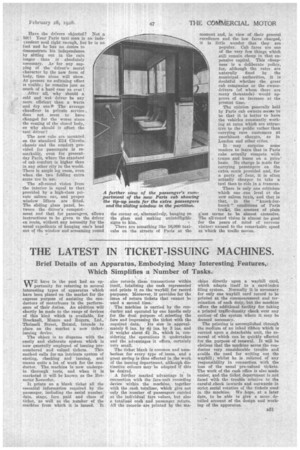THE LATEST IN TICKET-ISSUING MACHINES.
Page 57

If you've noticed an error in this article please click here to report it so we can fix it.
Brief Details of an Apparatus, Embodying Many Interesting Features, Which Simplifies a Number of Tasks..
WE have in the past had an opportunity for referring to several interesting types of apparatus which have been placed on the market for the express purpose of assisting the conductors of motorbuses in the performance of their duties. An addition will shortly be made to the range of devices of this kind which is available, for Breeknell, Munro and Rogers, Ltd., Thrissell Street, Bristol, intends to place on the market a new ticketissuing device.
The object is to dispense with the costly and elaborate system which is now generally employed of issuing prenumbered and valued tickets. This method calls for an intricate system of storing, checking and issuing, and means quite a lot of work for the conductor. The machine is now undergoin thorough tests, and when it is marketed it will be known as the Bremeter Recorder.
It prints on a blank ticket all the essential information required by the passenger, including the serial number, date, stage, fare paid and class of ticket, as well as the number of the machine from which it is issued. It
also records these transactions within itself, totalizing the cash represented and prints it on the waybill for record purposes. Moreover, it provides for the issue of return tickets that cannot be used a second time.
The machine is carried by the Conductor and operated by one handle only for the dual purpose of selecting the fare and impressing the ticket with the required data. Its size is approximately 6 ins, by 4 ins. by 3 ins. and it weighs about 0, lb., which is, considering the operations it undertakes and the advantages it offers, certainly very small.
The ticket blank is common and numberless for every type of issue, and a great saving is thus effected in the work of the issuing department, although distinctive colours may be adopted if this be desired.
A further marked advantage is in connection with the fare-unit recording device within the machine, together with the cash totalizer, which give not only the number of passengers carried at the individual fare values, but also a totalized cash and passenger return. All the records are printed by the ma
chine directly upon a waybill card, which adapts itself to a card-index filing system. Normally it is necessary for only one waybill card record to be printed at the commencement and termination of each duty, but the machine offers the additional facility for taking a printed traffic-density check over any section of the system where it may be deemed necessary.
The printing is accomplished through the medium of an inked ribbon which is carried upon a detachable unit, the removal of which can be quickly effected for the purpose of renewal. It will be obvious that the machine saves the conductor very considerable trouble and avoids the need for writing out the waybill; whilst he is relieved of any responsibility in connection with the loss of the usual pre-valued tickets. The work of the cash office is also made easier, and the ticket department is not faced with the trouble relative to the careful check inwards and outwards,. in strict serial rotation of the tickets used in the machine. • We hope, at a later date, to be able to give a more detailed account of the design and Work
ing of the apparatus.. .




















































































































